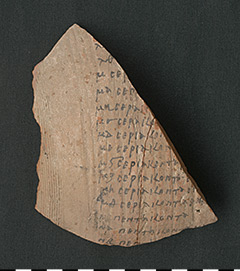SB XXVI 16522 (P. 12750)
Most of the finds from antiquity are quite everyday objects. This also applies to the documentary texts found in Egypt, most of which are receipts, tax declarations or lists and allow insights into the everyday life of the time. Sometimes they also include exercises or memory lists, such as the number exercise on potsherd presented here.
The potsherd was acquired by the coptologist Carl Schmidt, who is known primarily for his important role in the acquisition of Coptic manuscripts for the Berlin Papyrus Collection. Among the lesser-known acquisitions was this inscribed potsherd (ostracon). Due to the handwriting, which contains elements of both a bookhand and cursive, the ostracon can be dated to the 6th century AD, i.e. in the middle of the Byzantine period, which began in Egypt in the 4th century AD with the division of the Roman Empire into two parts. Egypt now belonged to the Eastern Empire of Byzantium with Constantinople as its capital.
The ostracon is only fragmentarily preserved and is composed of two fragments. An ancient Greek numerical exercise was written on the outside, of which the enumeration of the numbers 38 to 52 is preserved. The numbers are not only given as a sequence of figures, but are also juxtaposed with their corresponding numeral word. It is noticeable that the writer always uses an abbreviated spelling for the number words of the 40s, which does not correspond to the orthographically correct version. Such spelling mistakes and spelling variants are encountered frequently in the ancient texts from Egypt and are hardly surprising. People simply wrote the words as they pronounced them.
For the numerals, the writer of this list used the so-called Milesian numerals. This way of writing differs from the system used today in the western world in the sense that numbers were not represented by their own symbols, but by letters of the Greek alphabet. Thus α stood for 1, θ for 9 and ο for 70. However, there were also special characters for certain numbers, such as for the 6, which was represented with ϛ (stigma). The tens and hundreds were each given their own letters and signs. To represent numbers larger than 9 but not tens or hundreds, the desired units were attached to the smaller tens, hundreds, etc. closest to the number. Thus, 23 was written as κ for 20 and γ for 3.
One can only speculate about the context in which this list of numbers was written. It is conceivable, however, that it could be interpreted as an orthographic exercise for a pupil or a memorisation list in administration or commerce.



